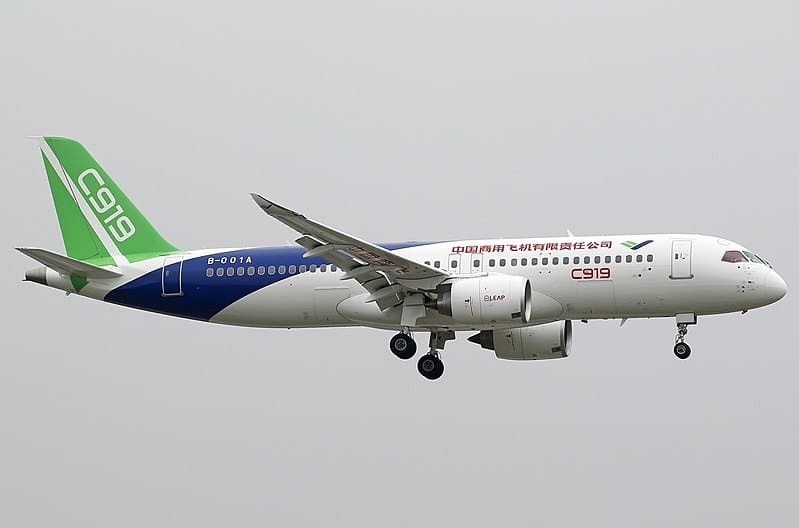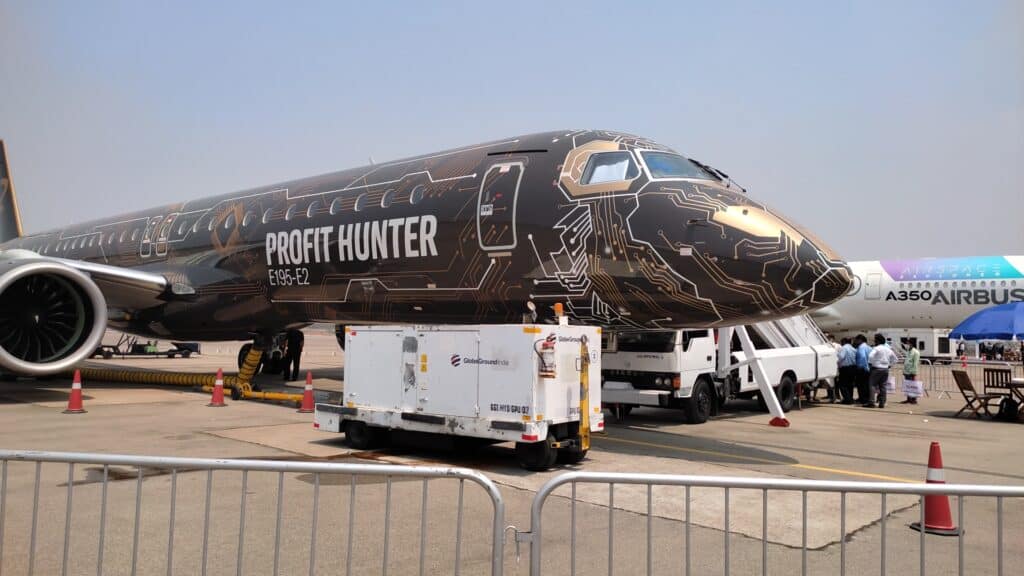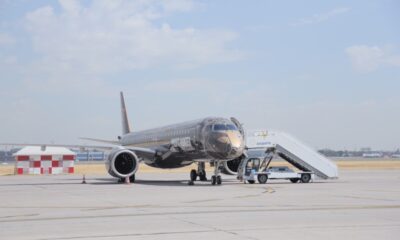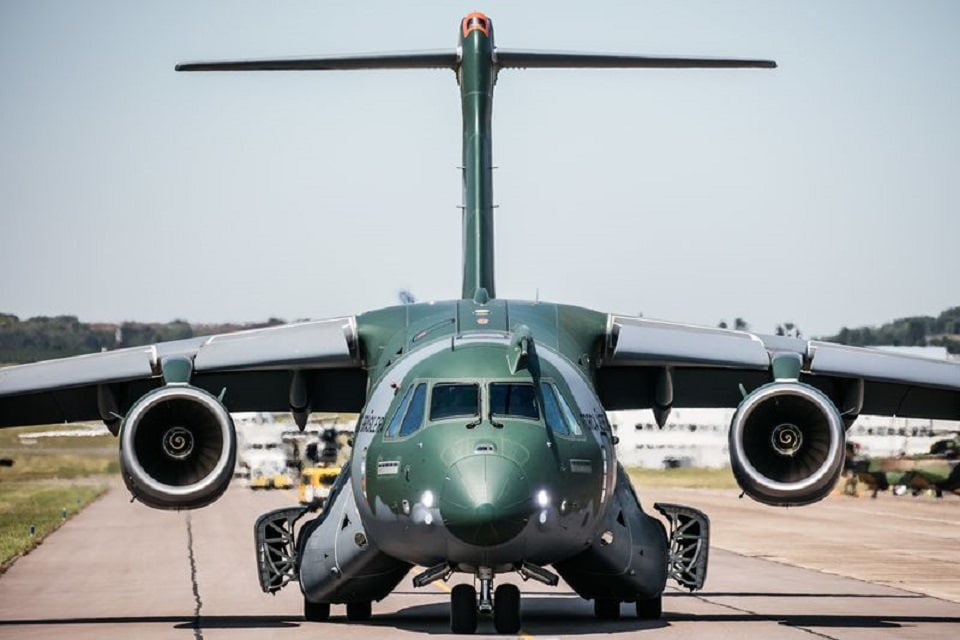Aircraft comparison
Aircraft comparisons between the Chinese built Comac C919 and the Embraer E195-E2.

In this article, we’ll look at the airplane comparison between the Comac C919 and Embraer E195-E2.
China’s COMAC C919 Narrow-body aircraft.
The C919 is the first domestic product of China that will be developed along with COMAC Company for both narrow and wide-body aircraft. The program was launched in 2008, and the first prototype was finished in 2015. It then underwent numerous tests in China to demonstrate its capabilities. Finally, on September 29th, 2022, it received the first Airworthiness Certificate from the Chinese Civil Aviation Authority, and on December 9th, 2022, this aircraft will be delivered to China Eastern Airlines in Shanghai.
Currently, there have been 800 orders for aircraft from various clients, with the majority of those orders coming from China. As the continuous sanctions imposed by western nations on Russia. If demand increases, China will be a key player in exporting some Comac aircraft to Russia.
Comparison of global 7500 v/s Gulfstream 700
Brazil’s Embraer E195-E2 Narrow-Body aircraft.
The medium-range jet airliner Embraer 195 E2 was created by the Brazilian company Embraer. For small airline operators, it is the most promising jet because it may be used for regional connections. The aircraft was introduced during the 2013 Paris Air Show. 2016 had seen the launch of the E190-E2’s first variant. And in 2018, it began operating in the operations with Wideroe as its first client.
It has three different types of aircraft, depending on the number of seats and trip distance. Embraer targets lower fuel consumption of 16–24% and maintenance costs per seat of 15–25%. Built on the first version of the E-Jet, it features a new fly-by-wire system, new pylons, landing gear, horizontal stabilizers, cabin, cabin air system, air cycle machine, and cabin.
Can the J20 from China match the American F-22? Let’s look at it in Comparison.
The Airbus A220 is a direct competitor in this market, and its cost is 91.2 million dollars, whereas the E195-E2’s cost is only $60.4 million. Embraer has currently received an order for 227 E195-E2 aircraft, of which 39 have been delivered to customers.
Comac C919 and Embraer E195-E2 specification
- Comac offers two different seating arrangements, with 168 seats for one class and 158 seats for two classes.
- Additionally, E195-E2 contains 146 seats for the single class and 120 capacity seats for the two classes.
- The C919 aircraft is 127.7 feet long, while the Embraer is 136.2 feet long.
- The c919’s wingspan is 110.3 feet while the Embraer’s is 110.6 feet.
- The C919 is 39.2 feet tall, while the Embraer is 35.8 feet tall.
- While the Embraer can carry 16150 kg, the C919 can carry up to 18900 kg.
- Operating empty, the weighs E195 E2 is 35700 kg and C919 45700 kg, respectively.
- The maximum takeoff weight for the E195-E2 is 61500 kg and for C919 is 78900 kg.
- The C919’s range is approximately 5575 km, while the E195’s range is 4917 km.
- The C919’s CFM engine generates 129.9-kilo newtons of thrust, whereas the Embraer’s two Pratt & Whitney engines can produce up to 102-kilo newtons of thrust.
- The C 919 has a list price of approximately $99 million, while the Embraer costs $60.1 million.

Aircraft comparison
Comparison of Osprey vs Chinook Helicopter

Helicopters play a crucial role in military and civilian operations worldwide, providing vertical take-off and landing capabilities, versatility, and mobility in various missions.
Among the widely recognized helicopters in military service are the Osprey and Chinook. Both have distinct designs and capabilities, tailored to meet specific operational requirements. In this comparison, we will delve into the features, capabilities, and roles of the Osprey and Chinook helicopters, examining their differences and strengths.
The V-22 Osprey is a tiltrotor aircraft, meaning it can take off and land vertically like a helicopter but also tilt its rotors forward to fly like an airplane. This design allows the Osprey to achieve higher speeds compared to conventional helicopters. The cruising speed of the V-22 Osprey is around 241 knots (277 mph or 446 km/h).
On the other hand, the Chinook helicopter, such as the Boeing CH-47 Chinook, has a cruising speed typically around 170 knots (196 mph or 315 km/h). While the Chinook is a highly capable and versatile helicopter known for its heavy-lift capabilities and reliability, it generally operates at lower speeds compared to the Osprey.
The comparison between an Osprey and a Chinook helicopter involves contrasting two distinct aircraft with different designs, capabilities, and purposes:
Dimensions:
- The Osprey has a length of 57 ft 4 in (17.48 m). while Chinook is significantly larger, with a length of 98 ft (30 m).
- Performance:
- The Osprey boasts a maximum speed of 275 knots (316 mph) and a range of 879 nautical miles (1,012 mi), making it faster and having a longer range compared to the Chinook.
- The Chinook has a maximum speed of 170 knots (196 mph) and a range of 400 nautical miles (460 mi), providing commendable performance but falling short of the Osprey in terms of speed and range.
- Powerplant:
- The Osprey is powered by 2 × Rolls-Royce T406-AD-400 turboprop/turboshaft engines, providing ample power for its vertical and horizontal flight modes.
- The Chinook is equipped with 2 × Lycoming T55-GA-714A turboshaft engines, each delivering 4,733 shp (3,529 kW) of power.
- Weight and Payload Capacity:
- Osprey: The Osprey has an empty weight of 31,818 lb (14,432 kg) and a gross weight of 39,500 lb (17,917 kg). Its maximum take-off weight (VTOL) is 47,500 lb (21,546 kg).
- Chinook: The Chinook has an empty weight of 24,578 lb (11,148 kg) and a maximum takeoff weight of 50,000 lb (22,680 kg). This indicates that the Chinook can carry heavier payloads relative to its own weight compared to the Osprey.
In terms of performance, the Osprey has a higher rate of climb ranging from 2,320 to 4,000 feet per minute, whereas the Chinook boasts a rate of climb of 1,522 feet per minute.
Additionally, the Osprey has a service ceiling of 25,000 feet, allowing it to operate in high-altitude environments more effectively compared to the Chinook, which has a service ceiling of 20,000 feet.
Osprey can carry up to 24 troops or 20,000 pounds of internal cargo and has a top speed of around 315 miles per hour (507 km/h). While Chinook can carry up to 55 troops or 24,000 pounds of cargo internally and has a top speed of around 170 miles per hour (274 km/h).
The Osprey is utilized by the U.S. Marine Corps, U.S. Air Force Special Operations Command, and other military forces around the world.The Chinook is widely used by the U.S. Army and various other military forces worldwide, including the UK, Canada, and others.
Aircraft comparison
Comparison of Russian Irkut MC-21vs Airbus A320neo
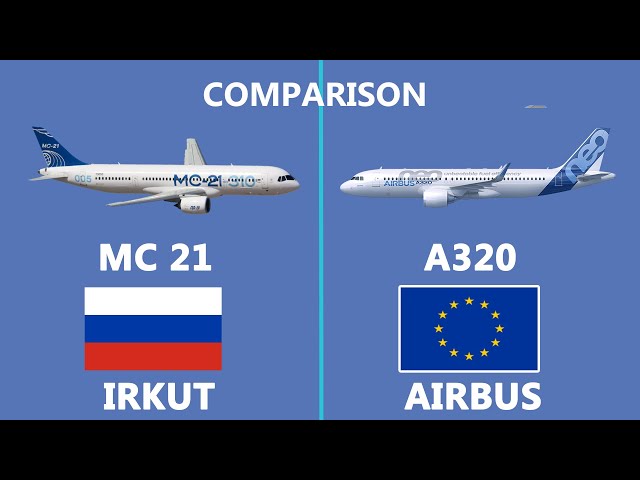
Russia is on the brink of advancing its aircraft industry in response to Western countries’ sanctions on aerospace components. They are developing a potential competitor to Western aircraft such as the Boeing 737 Max and the Airbus A320.
The Irkut MC-21 and the Airbus A320 are both narrow-body, single-aisle commercial aircraft designed for short to medium-haul flights. While the Airbus A320 has been a longstanding and widely used aircraft in the aviation industry, the Irkut MC-21 is a newer entrant that aims to compete in the same market segment.
In this article, we will conduct a comprehensive comparison between two notable aircraft: the MC 21 and the A320. Join us as we delve into each section to gain a better understanding of these aircraft and their capabilities.
mc 21
The MC-21, also called the Irkut MC-21, is a cutting-edge, contemporary narrow-body twinjet airliner built in Russia that was created and manufactured by Irkut Corporation. The MC-21, which made its first flight in 2017, is a technological be amazed at its advanced aerodynamics, fuel efficiency, and roomy, passenger-friendly cabin.
The well-known narrow-body, twin-engine Airbus A320 is now a mainstay of the world’s aviation fleet. Since its introduction in 1988, the A320 family has come to represent efficiency, dependability, and state-of-the-art technology. Airlines can choose the A320 series as a flexible option for short- to medium-haul routes with its unique wide cabin and sophisticated fly-by-wire control system.
In terms of cockpit crew, both aircraft accommodate a standard two-person crew. However, when it comes to passenger capacity, the MC-21-300 offers a configuration with 163 seats in a two-class setup (16J + 147Y), while the A320 has a slightly smaller capacity with a range of 140 to 240 passengers.
Moving on to dimensions, the MC-21-300 has a length of 42.2 meters (138 ft), whereas the A320 is slightly shorter at 37.57 meters (123 ft 3 in).
The MC-21-300 also has a wider wingspan, standing at an unspecified width, compared to the A320’s 35.8-meter (117 ft 5 in) wingspan.
The MC-21-300 has a maximum take-off weight of 79,250 kg (174,720 lb), slightly exceeding the A320’s maximum take-off weight of 78,000 kg (172,000 lb).
With a maximum payload of 22,600 kilograms (49,800 pounds), the MC-21-300 surpasses the A320, which has a maximum payload of 19.9 tons (44,000 pounds). This can impact the aircraft’s flexibility in carrying passengers, cargo, or a combination of both.
The MC-21-300 boasts a 2-class range of 6,000 kilometers (3,200 nautical miles), while the A320 has a range of 3,300 nautical miles (6,100 kilometers) under certain parameters. The MC-21-300 is equipped with Aviadvigatel PD-14 turbofan engines, while the A320 features the Pratt & Whitney PW1431G engines with a thrust of 31,000 lbf (140 kN).
Engine Upgrade
The Airbus A320 stands out as a popular aircraft in the narrowbody segment, offering a range that spans from shorter distances to longer routes. Airbus has extended its capabilities with the introduction of the much-anticipated A321XLR, designed for extended flights. The aircraft showcases breakthrough technologies that contribute to its overall advancement.
Notably, Airbus has experienced a higher number of orders for its narrowbody aircraft compared to its competitors. The A320neo, or “New Engine Option,” represents a significant leap forward. It boasts new engine choices, allowing airlines to opt for either the Pratt & Whitney PW1000G geared turbofan engine or the CFM International LEAP-1A engine.
In response to past challenges with one of its engines, Airbus is gradually transitioning to CFM engines. The previous engine-related issues resulted in setbacks for airlines and manufacturers alike. This shift underscores Airbus’s commitment to addressing concerns and ensuring the reliability of its aircraft.
The A320neo, an enhanced iteration of the A320, is a testament to Airbus’s dedication to incorporating cutting-edge technologies and more fuel-efficient engines. This evolution aims to improve overall performance while aligning with environmental sustainability goals.
As per reports from Russian sources, the Irkut MC-21 has achieved a milestone by successfully concluding over 160 test flights powered by the PD-14 engine. Furthermore, the aircraft’s wing has undergone a comprehensive test cycle, demonstrating positive endurance results. The PD-14 engine, developed by the United Engine Corporation (UEC), has played a pivotal role in the aircraft’s success, complementing the domestically produced composite wing.
Orders
Recently, Sergey Skuratov, the director-general of Ural Airlines, unveiled the carrier’s ambitious plan to acquire 40 Irkut MC-21s for its fleet. This announcement signals a noteworthy shift in Russia’s aviation landscape, as many airlines in the country are considering the adoption of domestically manufactured aircraft to replace their existing narrow-body planes sourced from Western countries. This move represents a significant milestone for Russia as it endeavors to establish a more prominent presence in the global commercial aviation sector.
While Airbus, with its extensive worldwide customer base and a substantial number of airplane orders, may not feel an immediate impact, the potential loss of the Russian market could pose challenges. The MC-21’s success in the Chinese market, in particular, could present hurdles for Airbus, given its significant market share. Despite facing sanctions on Western components, Russia continues to operate its A320 fleet, showcasing its resilience in meeting current and future demands for aviation passengers.
Aerospace
Boeing 777-8F vs Airbus A350F: Comparing two Premium aircraft
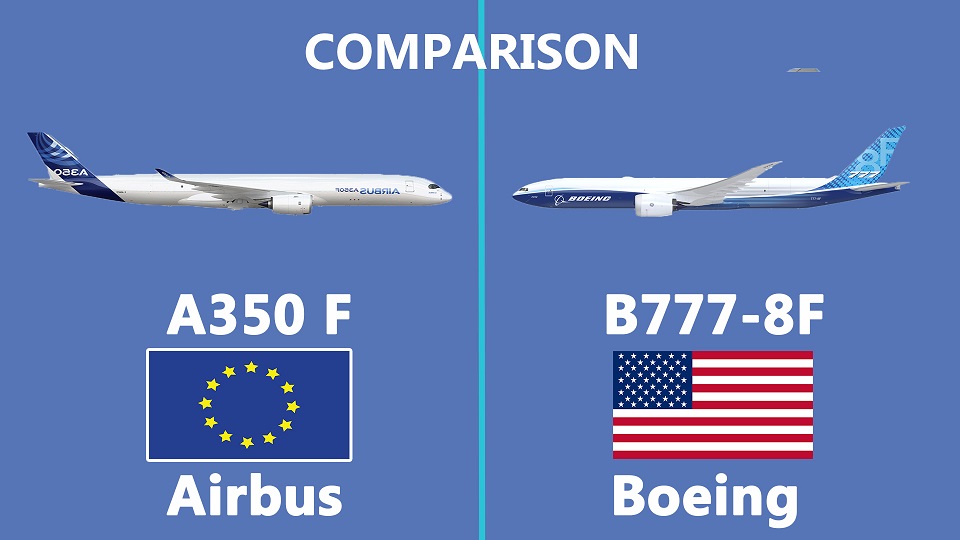
In the world of aviation, competition is a constant force. With the aftermath of the COVID pandemic, many airlines have been making a strong comeback, showing robust profit margins. Furthermore, the demand for freight services has been on the rise, necessitating the need for high-end aircraft in this sector.
In this narrative journey, we’re about to embark on, we’ll delve into the realm of two exciting newcomers in the freighter aircraft segment: A350 vs 777, The Airbus A350 Freighter, and the Boeing B777-8 Freighter.
These aircraft are born from the same lineage as their passenger counterparts but have been reimagined for the world of cargo transportation. Our exploration will take us through the fascinating similarities and differences between these two aircraft, examining their capacity, operational viability, and what they bring to the airlines that operate them.
Airbus A350F
The A350F can be seamlessly integrated into airline fleets, delivering step-change efficiency in terms of volume, range, and payload.
Airbus is proud to bring the A350F as the only choice for the future of the large widebody freighter market
The A350F, as proclaimed by Airbus, possessed an almost otherworldly ability: it showcased an unbeatable fuel efficiency that set a new benchmark for its competitors. With awe-inspiring prowess, it achieved a staggering 40% reduction in fuel consumption and carbon dioxide emissions when compared to the venerable 747F.
But the brilliance of the A350F didn’t end there. It was a revelation in seamless integration for airline fleets. As if answering the prayers of airlines worldwide, this aircraft seamlessly joined its ranks, ready to revolutionize air travel. Its introduction marked a step-change in aviation efficiency, touching every aspect of the industry.
Boeing’s 777x Aircraft and the Evolution of Air Freight
Boeing is keeping pace with advancements in aviation, showcasing its much-anticipated Boeing 777x aircraft, currently in the testing phase. Responding to Qatar Airways’ call, Boeing is exploring the development of a 777X-based freighter to replace the existing 777Fs.
This cutting-edge aircraft boasts next-generation avionics and technology, featuring a powerful engine that significantly elevates its performance. The extended wing structure not only enhances aerodynamics, reducing drag during cruising for improved fuel efficiency but also contributes to lower fuel consumption.
Introducing the 777-8 Freighter, Boeing extends its freighter family as the world’s most capable and fuel-efficient freighter, aligning with sustainability goals. The Boeing freighter family ensures optimal payload capacity and range capabilities, all while maintaining superior economics. This includes the high-volume 747-8 Freighter and the long-range 777 Freighter, solidifying Boeing’s commitment to delivering innovative solutions for the future of air freight.
| Boeing 777-8F vs Airbus A350F – Specifications | ||
|---|---|---|
| A350F | 777-8F | |
| Length | 70.8m | 70.8m |
| Height | 17.1m | 19.5m |
| Wingspan | 68.75m | 71.8m |
| Maximum take-off weight (MTOW) | 319,000kg | TBC |
| Cargo capacity main deck | 30 pallets main deck, 12 in lower hold | 30 pallets main deck, 12 in the lower hold |
| Total cargo volume | TBC | 766.1m3 |
| Net revenue payload | 109,000kg | 112,264kg |
| Range | 4,700nm | 4,410nm |
| Engines | 2x Rolls-Royce Trent XWB | 2x General Electric GE9X |
Boeing 777-8F and A350F Capacity
The A350F is derived from the A350-1000 and the 777-8F will have the key features of Boeing’s 777X design, including its carbon-fiber wing – the longest single composite part ever developed for an aircraft. The 777x vs A350 is unique in technology.
The 777-8F will be slightly larger than the A350F, with a marginally longer fuselage, taller height, and a wider wingspan. At 70.8m, the A350F will be slightly shorter than the 73.7 m-long passenger A350-1000.
On cargo payload and range, Airbus says the A350F will carry 109,000kg over 4,700nm. Boeing’s data notes the 777-8F will carry 112,300kg over 4,410nm.
And while the A350F’s main-deck cargo hold will have capacity for 30 pallets (measuring 244 x 318cm), with another 12 of the same size in the lower hold, the 777X will carry 31 pallets (again 244 x 318cm) on the main deck, and 13 in its lower hold. Essentially, the 777-8F will carry slightly more cargo, but the A350F will be able to fly further.
Boeing 777-8F and A350F efficency
Airbus stands to gain significant advantages by promptly introducing the A350F into service, recognizing the absence of a compelling cargo aircraft in its portfolio. Leveraging the already-established certification of the A350 family further reinforces its position.
In contrast, Airbus A350 vs Boeing 777. Boeing adopts a more measured approach, as the continued reception of orders for the 777F allows for sustained production over the next five years. This strategy provides a smoother transition toward the eventual production of the 777-8F.
The European aircraft manufacturer highlights that the A350 F will feature a 17% increase in revenue cargo volume and a payload capacity of 3,000kg greater than the current generation Boeing’s 777-9F.
In contrast, Boeing asserts that Boeing’s 777-9F will outperform the current Boeing 777F by carrying 17% more revenue payload. Boeing aims to provide the “highest payload and long-range capability” to explore new markets while ensuring a balance of “low operating cost with high reliability.”
Airbus emphasizes the A350 F unparalleled space for customers, claiming an 11% volume increase that accommodates an additional 5 pallets. The A350 F boasts a lighter Maximum Takeoff Weight of 30 tonnes and an impressive 99.5% operational reliability.
Further setting it apart, the Airbus A350 F features a cargo side door that surpasses competitors in size. Additionally, it promises a 20% reduction in fuel burn, contributing to enhanced efficiency and sustainability.
Airbus stands to gain significant advantages by promptly introducing the A350 F into service, recognizing the absence of a compelling cargo aircraft in its portfolio. Leveraging the already-established certification of the A350 family further reinforces its position.
In contrast, Boeing adopts a more measured approach, as the continued reception of orders for Boeing’s 777-9F allows for sustained production over the next five years. This strategy provides a smoother transition toward the eventual production of Boeing’s 777-9F.
B777-8F and A 350F orders as of Nov 2023
Currently, both freighter versions of these aircraft are pending. The Airbus A350, initially known for its passenger variant, is already operational in the market, catering efficiently to the passenger segment. Airbus is now extending its capabilities by developing the freighter version, scheduled for its maiden flight in 2026. Since its introduction in July 2021, Airbus has secured 39 firm orders for the A350F, with the unveiling of the inaugural aircraft’s livery at the Paris Air Show.
On the Boeing front, the 777-8F aircraft is undergoing a transition from the passenger to the freighter version. The cargo variant, 777-8F, is anticipated to be introduced in 2028. In contrast, the passenger version, 777-8, does not have a confirmed timeline. Qatar Airways, a major customer, has placed orders for approximately 74 aircraft, with additional orders from various other airlines, totaling around 90 aircraft as of 2023. Boeing currently leads in terms of order volume compared to Airbus.

